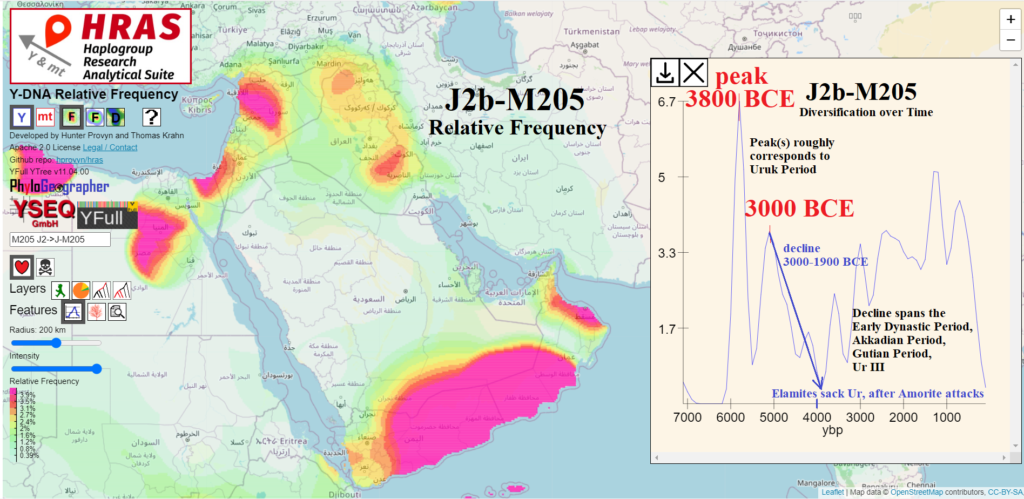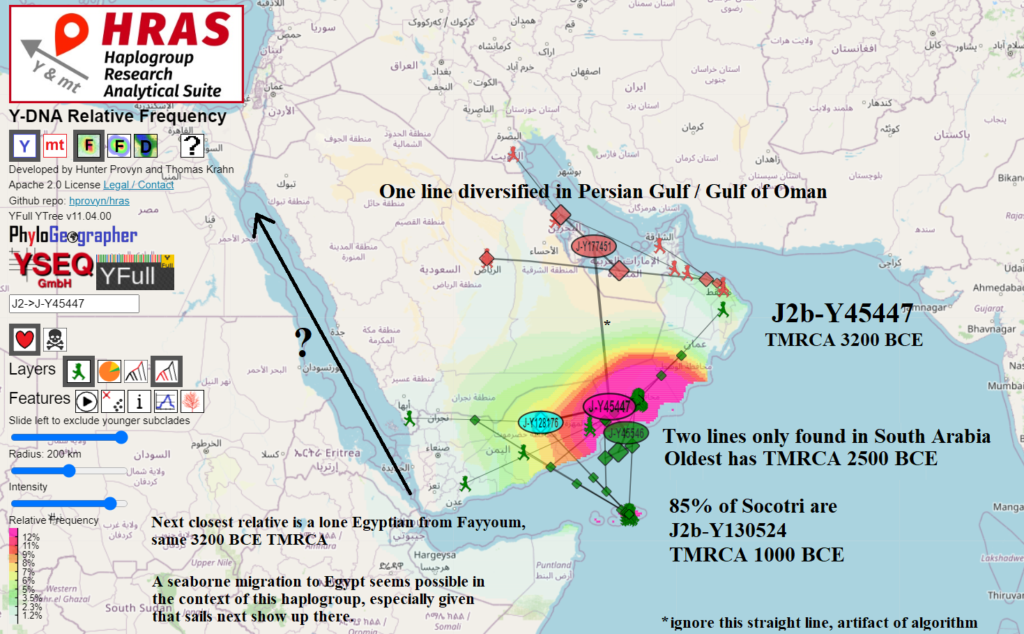There are no ancient DNA samples yet found to prove that the origin of J2b-M205 is in or around Sumeria or Mesopotamia in general. In this article, I examine several types of circumstantial evidence, including diversification over time charts, diversity maps, the geography of the oldest ancient J2b samples, and sea trade links between Egypt, South Arabia and Sumeria that could be related to the development of the sail, that I think support the theory that the bulk of J2b-M205 diversification around 5800-5000 years ago was tied to the Uruk Period of cultural expansion and migration out of Sumeria to other parts of the Near East.

While Y-DNA haplogroup J2b-M205 accounts for a meager 2.7% of all Iraq samples on the YFull YTree, it peaks in South Arabia around 27% (26/95) in Dhofar and a whopping 86% (18/21) of Soqotri are positive.
The diversification over time graph shows two peaks, one at 3800 BCE and one at 3000 BCE. These two peaks might actually represent a single peak somewhere between the two maxima over the 800 year period. If HRAS had used a longer interval to compute the Gaussian smoothing, this would be indicated by the chart (I plan to make the smoothing parameters configurable in a future update in 2023).
This/these peak(s) roughly correspond to the Uruk Period of Sumeria. I discuss the evidence for migrations from Sumeria throughout the Near East in more detail in the video I made in Nov 2021, providing some quotes from Marc Van de Mieroop, Belgian Assyriologist and Egyptologist, from his book A History of the Ancient Near East, ca. 3000-323 BC.
An interesting question to address is the relative decline in diversification of J2b-M205 during the Early Dynastic Period. This period, while noted for the development of writing and other innovations in urban organization may not have seen the same level of population growth as the preceding Uruk Period. Also, supposedly there was a catastrophic flooding of the rivers of Mesopotamia around 2900 BCE (reference: https://www.worldhistory.org/Early_Dynastic_Period_(Mesopotamia)/).
The closest center of J2b-M205 diversity to ancient J2b-M102 samples is Mesopotamia

Normally I would have led the article with this J2b-M205 diversity map on which I have overlaid the most ancient J2b samples. This is perhaps the most compelling evidence that J2b-M205 more likely originated in Mesopotamia rather than other areas of high diversity, like the Levant or South Arabia. This is because Mesopotamia is significantly closer to the locations of the four oldest J2b-M102 samples, found in an arc from western Georgia, Azerbaijan to western Iran.
Why do I favor Sumeria vs Mesopotamia in general for J2b-M205 origin?
There are two main reasons I favor Sumeria vs Mesopotamia in general for the origin of J2b-M205, access to the sea and linguistic.
The high diversity of this line in South Arabia seems more likely possible if it originated in Sumeria, which was on the Persian Gulf coast in the 4th millennium BCE, vs landlocked Subartu further north.
In northern Mesopotamia, Subartu, they were speaking now-extinct East Semitic languages, for example, Akkadian. Since its most closely related Semitic languages are found further west, rather than in the J2b-M102 homeland further north and east, it stands to reason that at least some element, if not the majority, of the pre- 4th millenium BCE Subartu population (i.e. pre Uruk Period) came from further west. Before the Bronze Age, language spread through elite dominance seems less viable vs demic diffusion.
While the language of Sumerians, Sumerian, is not yet reliably found to be related to any other language family, it does not have this baggage tying its speakers to a western origin like the languages spoken in Subartu.
Invention of the Sail roughly matches the TMRCA of Persian Gulf – Oman Gulf – South Arabian of J2b-Y45447
I recently watched a documentary on the Bronze Age on Curiosity Stream (sadly no referral program so I get nothing if you click) and came away from it motivated to reexamine J2b-M205 using HRAS analytical and visualization tools.
“We have gold, we have ebony, we have ostrich eggs that are moving between the elite of the different societies at this period throughout the eastern Mediterranean, between the palaces, between the kings.” – Emily S. K. Andersen, PhD, Senior Lecturer, Classics and Art History, Johns Hopkins University
“Revolutionary innovations marked a booming era of maritime trade. One of the most important was the sail.” – narrator
“The sail was probably first used in the 4th millennium, perhaps in southern Mesopotamia. By about 2000 BC it’s found its way to Crete, probably via Egypt, where we know that there were sailing ships by about 3200 BC.” – Tom Tartaron, PhD, Associate Professor of Classical Studies

The current implementation of HRAS computes a subclade’s approximate theoeretical origin independently of the distribution of its siblings and cousins. For more details on the algorithm and visualization check out the informative and illustrative HRAS documentation:
https://hras.yseq.net/documentationPage.html#MigrationsToChildren
My interpretation is that the J2b-Y45447 MRCA may have been a sailor / merchant originally tracing his male line to Sumeria who profited from the invention of the sail. He may have been born in Sumeria or Dilmun and may have sired lineages himself along the coasts of South Arabia in 3200 BCE (or descendants did by 2500 BCE) and his brother / cousin may have accompanied him there and later sailed to Egypt via the Red Sea at the time of the introduction of the sail to Egypt.
At least one of his descendants, J2b-Y45546, appears to have been established in South Arabia by 2500 BCE because the descendants are only found there. However we are dealing with limited data here – there is only one basal sample (from Dhofar, Oman) and the single child line has a very late TMRCA of 1000 BCE. So a later co-migration of related men to South Arabia cannot be excluded.
2500 BCE coincides with the end of the third subperiod of the Early Dynastic Period (ED). So there would have been demand among the elite of various city states, especially Kish in the north and Uruk in the south, for status-enhancing trade goods, for one’s own use or as political gifts. So I think given this context, and the possibility of a co-migrating cousin to Egypt by the sea, that J2b-Y45546 may have engaged in long-distance sea trade between Sumeria/Dilmun and South Arabia by 2500 BCE.
I have an article devoted to the peopling of Socotra by the subclade J2b-Y45076.
Nice article. J-M205 has 103 + 4 SNPs added from J-M102, and in comparison, JM241 has 35 + 4 + 4 SNPs added. Why is it that the age for diversification predicted by you for J-M205 is 5800-5000 ybp whereas the age for diversification of J-M241 is greater than 8000 ybp?
Hello !
I really liked your research about j2 haplogroup
But i will ask you if there is an evidence that the rare T haplogroup really peaked in uruk sumeria or no
I am asking because I’ve searched a-lot about it and found little information that t can be part of sumeria and there sister haplogroupL is in the Indus valley which makes little sense since both can be dravidian
I am not really sure
Thank you and excuse my english